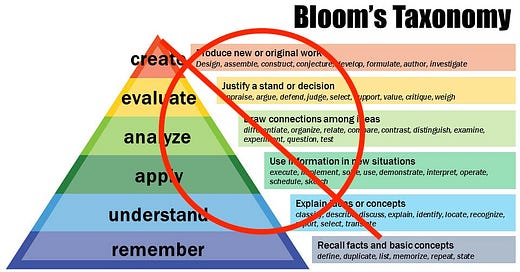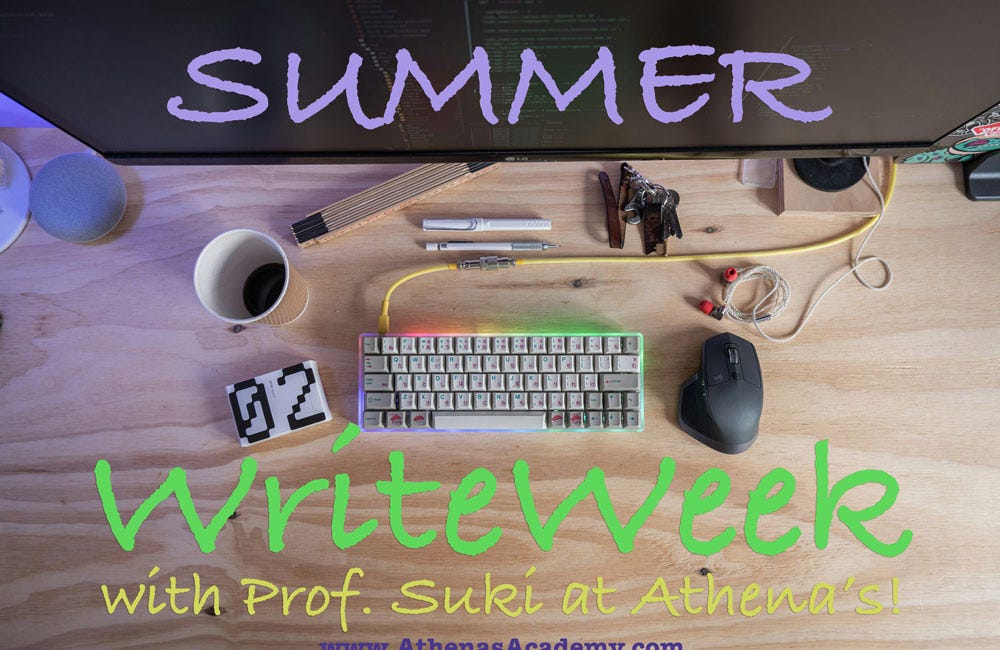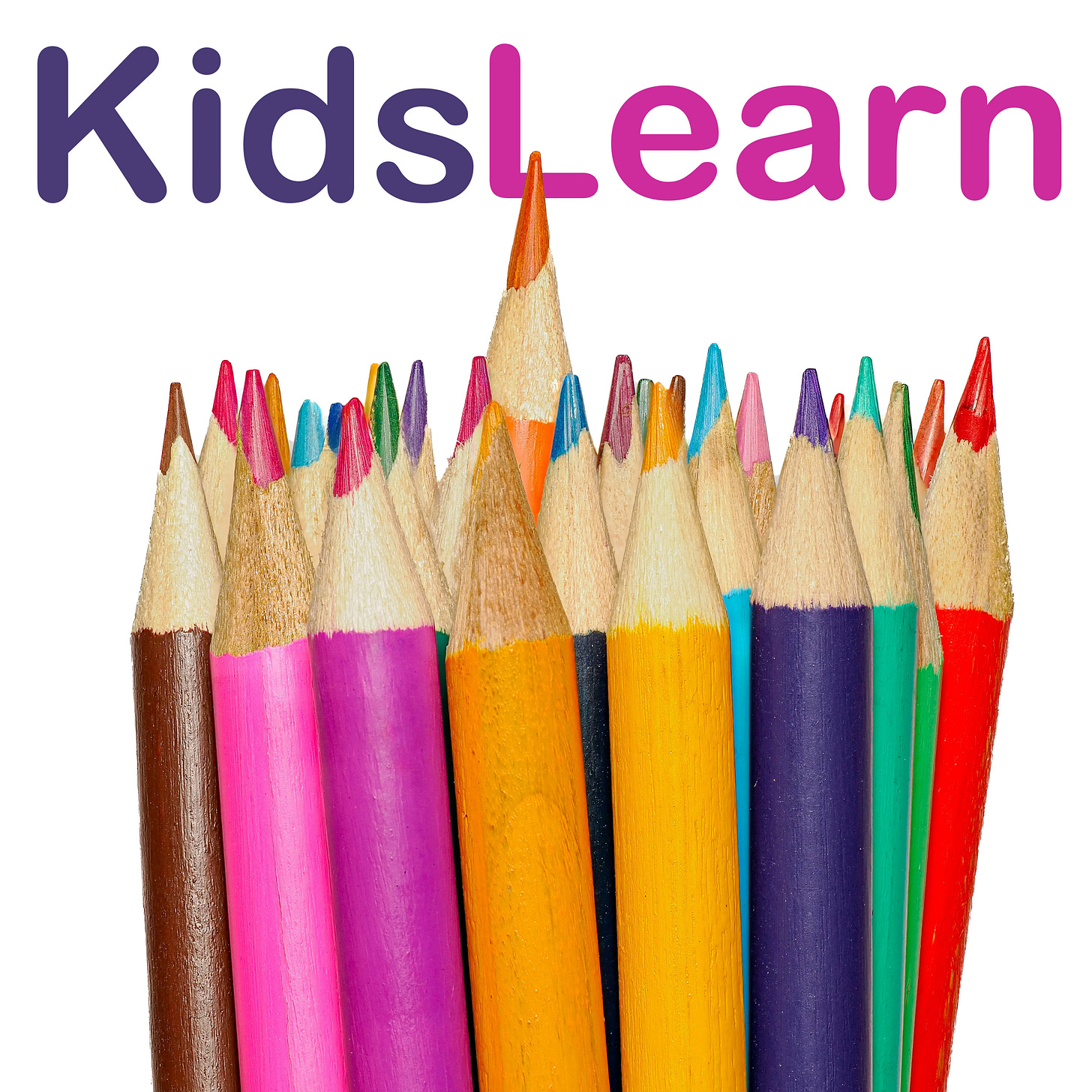The KidsLearn Substack is written by Suki Wessling, known as “Prof.” Suki to her students. Scroll to the bottom for links to Suki’s work and more information.
I love the essay form. Check out The Babblery if you don’t believe me. I love informative writing. I love argumentative writing. I love investigative writing. I need (and tolerate) academic writing.1
But I teach creative writing. And I believe that it’s important to start writing instruction with creative explorations before doing any work on academic writing.
The importance of summer writing time
Join me this summer for a weeklong intensive! We'll set a goal, write, share our work, write, chart our progress, write, edit, and then publish in our literary journal, Athena's Quill!
Find the ideas first, forget about the rules
Academic writing instruction is all about the rules. Here’s how you write a sentence. Here’s how you punctuate. Here’s how you write a paragraph. Here’s the most boring essay form ever.2 Here’s how you write a conclusion.
But we all know that the way to shut kids down is to start with the rules. I started teaching kids as a homeschooler, which is when I started reading teaching pedagogy for kids. (I had previously only taught adults.) I was shocked by how many teachers bought the ideas behind Bloom’s Taxonomy.
Did they really believe that before creating, students had to remember, understand, apply, analyze, and evaluate? Really?
I wondered if people who write educational pedagogy had ever watched a child learn.
Take a cue from our quickest learners
There’s a lot of disagreement about what a gifted child is: is this an inborn trait, one that’s encouraged by environment, or both or something different? But there’s no disagreement that when you watch a gifted learner in action, it’s like watching a time lapse photo of a flower blooming. A typical learner blooms; a gifted learner explodes.
Gifted writers don’t start by learning the rules; they start with creative inspiration. And they do that not because they won’t ever care about or need the rules. They do it because almost all successful learning happens through exploration and enjoyment.3 Most gifted learners instinctively start where their interests lie and drill deep. My kid who recently got a degree in Mathematics started his math life by making me a Googol $ bill on adding machine paper!
How creative writing inspires learning
Writing comes from the soul,4 and by offering children the opportunity to write from their souls before they learn any rules, the first rule they teach themselves is the importance of self-expression. So much student writing is flat, boring, and programmatic because the students didn’t first learn the thrill of self-expression.
The next thing my students learn in creative writing is our mantra that in the first draft, “everything is ‘write’!” They learn to dump their ideas without concern for form, in many cases because no one has yet told them that there is an accepted form. “Writer’s block” is almost always “editor’s block”: a child’s internal editor, stoked by all the rules it’s sure the writer will break, whispers harsh criticism in the child’s ear as they write.
Once an inspired young writer rolls out their ideas and shares them, that’s when they learn that the transition from thought in their head to words on a page and then to understanding in someone else’s head is not as easy as it looks. In my creative writing courses, we don’t tell kids what is “wrong” with their writing. We tell them what we got from it and questions we have. The students find out how their writing was received and without being told what’s wrong, they learn better ways to express themselves.
Happy creative writers make more successful academic writers
Once children enjoy the process of writing and rewriting, they don’t approach academic writing with the trepidation that we commonly see. Sure, they don’t yet know the “rules” of academic writing, but now that we’re balancing Bloom on his tippy top, we’ve already got three basic skills covered: the students are creative, they’ve learned to evaluate their writing, and that has helped them establish the basis for analytic thinking about writing.
And something even more fundamental has happened on the way to their first forays into academic writing: they actually have learned many of the rules! Successful creative writing builds all of the skills that are foundational for good writing:
vocabulary development
strong sentences
well-organized and well-developed paragraphs
a structure that best illuminates the topic
understanding of what makes a piece of writing feel “complete”
Sure, they probably don’t understand citations, footnoting, and other non-creative skills, but these skills are hardly the basis for effective writing.
So turn Bloom on his pointy head and stoke kids’ enthusiasm for writing
When we draw on enthusiasm, we create the essential foundation for learning. Without enthusiasm at the base, learning to write is a chore and a bore.

I don’t love the 5-paragraph essay, but that’s for another post!
See 5-paragraph essay above.
I’m leaving a lot of room here to develop this topic more deeply. Stay tuned!
Yet another topic I will expand on!









